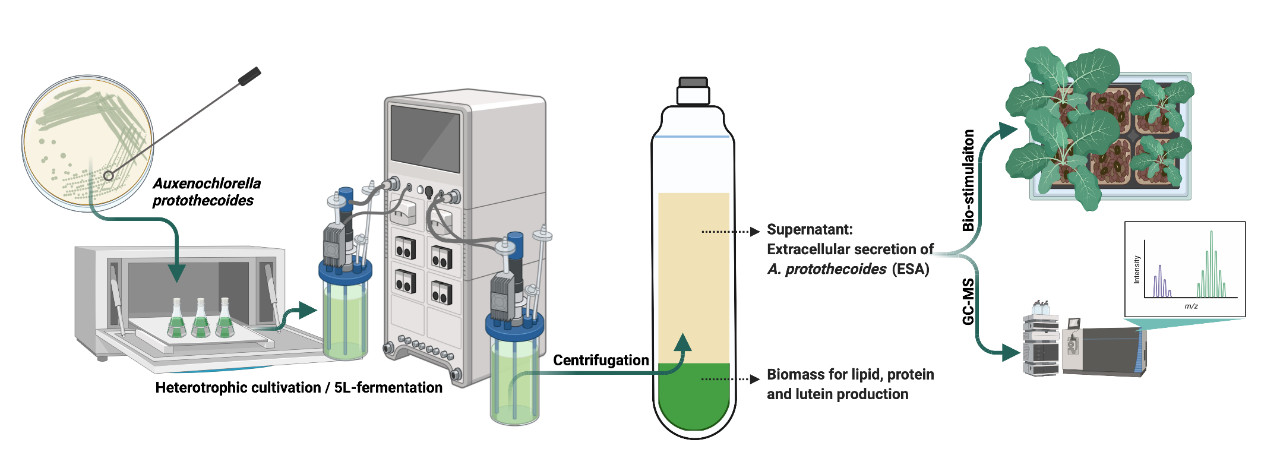Microalgae Bio-stimulant Research With Syngenta China
Recently, Extracellular Metabolites of Heterotrophic Auxenochlorella protothecoides: A New Source of Bio-Stimulants for Higher Plants was published online in the journal Marine Drugs by PROTOGA and Syngenta China Crop Nutrition Team. It indicates that applications of microalgae are expanded to agricultural field, exploring its potential of bio-stimulants for higher plants. The collaboration between PROTOGA and Syngenta China Crop nutrition team has identified and verified the feasibility of extracellular metabolites from microalgae tail water as a new bio-fertilizer, enhancing the economic value, environmental friendliness and sustainability of the entire industrial microalgae production process.

▲Figire 1. Graphical abstract
Modern agricultural production depends on chemical fertilizer to a large extent, but the excessive use of chemical fertilizer caused environmental pollution in soil, water, air and food safety . Green agriculture includes green environment, green technology and green products, which promotes the transformation of chemical agriculture to ecological agriculture which mainly relies on biological internal mechanism and reduces the use of chemical fertilizers and pesticides.
Microalgae are tiny photosynthetic organisms found in freshwater and marine systems that are capable of producing many different bioactive substances such as proteins, lipids, carotenoids, vitamins, and polysaccharides. It has been reported that Chlorella Vulgaris, Scenedesmus quadricauda, Cyanobacteria, Chlamydomonas reinhardtii and other microalgae can be used as Bio-stimulant for beet, tomato, alfalfa and other agricultural products which help improve seed germination, accumulation of active substances and growth of plants.
In order to reuse tail water and increase economic value, in collaboration with Syngenta China Crop Nutrition Team, PROTOGA studied the effects of Auxenochlorella protothecoides tail water (EAp) on the growth of higher plants. The results showed that EAp significantly promoted the growth of a variety of higher plants and improved stress resistance.

▲Figure 2. EAp Effect of EAp on model plants
We identified and analyzed extracellular metabolites in EAp, and found that there were more than 84 compounds, including 50 organic acids, 21 phenolic compounds, oligosaccharides, polysaccharides and other active substances.
This study suppose its possible mechanism of action: 1) The release of organic acids can promote the dissolution of metal oxides in soil, thus improving the availability of trace elements such as iron, zinc and copper; 2) Phenolic compounds have antibacterial or antioxidant effects, strengthen cell walls, prevent water loss, or function as signaling molecules, and play a key role in cell division, hormone regulation, photosynthetic activity, nutrient mineralization and reproduction. 3) Microalgae polysaccharides can increase the content of ascorbic acid and the activities of NADPH synthase and ascorbate peroxidase, thus affecting photosynthesis, cell division and abiotic stress tolerance of plants.
Reference:
1.Qu, Y.; Chen, X.; Ma, B.; Zhu, H.; Zheng, X.; Yu, J.; Wu, Q.; Li, R.; Wang, Z.; Xiao, Y. Extracellular Metabolites of Heterotrophic Auxenochlorella protothecoides: A New Source of Bio-Stimulants for Higher Plants. Mar. Drugs 2022, 20, 569. https://doi.org/10.3390/md20090569
Post time: Dec-02-2022